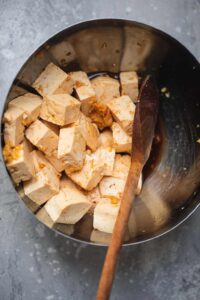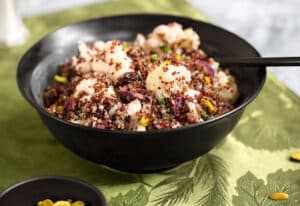Amazing amaranth, once a revered drop of the ancient Aztecs, is now coming back into use via the natural-food market. Native to Mexico, Guatemala, Peru, and Bolivia, grain amaranth (as it is often called, to distinguish it from vegetable amaranth, a closely related plant) is a tiny, round seed, about half the size of a millet seed.
Amaranth contains 16 percent protein and is unusually high in lysine and methionine, amino acids that are often in short supply in grains. In addition, it is among the grains highest in fiber and is quite rich in calcium and iron. Amaranth even contains vitamin C, a vitamin not usually found in significant amounts of grains.
The flavor of cooked amaranth is quite strong. It has been described as nutty and sweet, but it is more complex than that. Even its aroma is distinct and is not to everyone’s liking. Amaranth cooks to a rather sticky and glutinous texture, which limits its versatility. It can’t easily be substituted for other grains in recipes and is a bit too overpowering to be used as a simple bed of grains for vegetable or bean dishes. Amaranth’s unusual texture calls for a different approach.
Basic Cooked Amaranth: Use a ratio of 2 ½ to 3 parts water to 1 part grain, depending on the texture you want. The smaller amount of water yields a chewier result. Using more water will yield a consistency like a mushy cooked cereal. Bring the water to a boil and stir in the grain. Return to a boil, then lower the heat and simmer, covered, until the water is absorbed, about 20-25 minutes.
- As a hot cereal, cook as instructed above. Add a little non-dairy milk if desired and embellish as you would any other hot cereal, with dried or fresh fruit, rice syrup, nuts, and so on.
- The flavor of amaranth is compatible with that of various squashes. Use cooked amaranth laced with raisins, nuts, cinnamon, and grated ginger to stuff pre baked winter squash.
- Toast a small amount of the raw grain in a dry skillet and use as a topping for green salads, casseroles, or noodles.
- Add a small amount of cooked amaranth to muffin and quick-bread batters for a moist, chewy texture. About ½ cup per average recipe is right.
For lots more features on healthy lifestyle, explore VegKitchen’s Healthy Vegan Kitchen page.
Here are more of VegKitchen’s Natural Food Guides.






Comments
No Comments